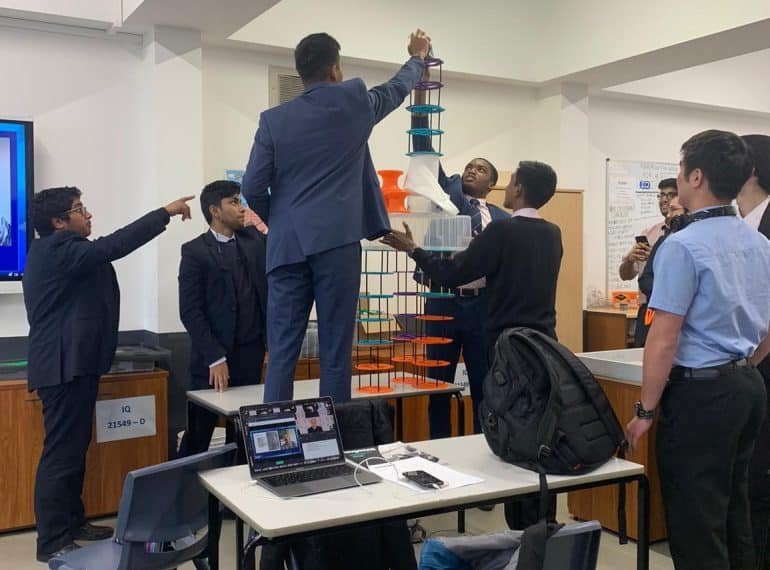
Experts have been helping QE A-level students see the exciting topical applications of their subjects in the real world in a series of lectures streamed into the School.
 Sixth-formers have already enjoyed stimulating day-long sessions on Medicine in Action, Chemistry in Action, Product Design in Action and Geography in Action, with a similar event for Biology due to take place in December.
Sixth-formers have already enjoyed stimulating day-long sessions on Medicine in Action, Chemistry in Action, Product Design in Action and Geography in Action, with a similar event for Biology due to take place in December.
The training days are run by The Training Partnership, the leading provider of external educational study days in the UK, and would normally be held in London, but are this year being conducted remotely because of Covid-19.
QE’s Head of Technology, Michael Noonan, said that the Product Design A-level students, and even a couple of “enthusiastic non-subject specialists”, enjoyed a “superb day” of lectures. “Favourite amongst the talks attended by students was Pioneering aeronautical innovation by Sam Rogers – an aeronautical engineer working in product development for Gravity Industries, a company who are currently developing a jetpack suit.”
One of the pupils attending, Paul Ofordu, of Year 12, said: “It was amazing to see the application of prototyping, testing and iterative design in such a high-end product development project.”
 The Resourcefulness and design lecture, delivered by Kingston University Senior Lecturer Pascal Anson, stimulated a practical activity, pictured. “Here we see some examples of structures which were resourcefully developed by the students using VEX IQ and EDR Robotics game elements – great thinking on their feet!” added Mr Noonan.
The Resourcefulness and design lecture, delivered by Kingston University Senior Lecturer Pascal Anson, stimulated a practical activity, pictured. “Here we see some examples of structures which were resourcefully developed by the students using VEX IQ and EDR Robotics game elements – great thinking on their feet!” added Mr Noonan.
Chemistry students gathered in the Main School Hall to hear engaging contributions from speakers who ranged from Andrea Sella, a synthetic chemist and broadcaster, talking about mercury – “the most beautiful element in the periodic table and the most reviled” – to marine engineer Hayley Loren exploring whether nuclear fusion could provide the solution to the world’s energy issues.
Julia Lister, QE’s Head of Chemistry, said: “The engaging Chemistry in Action lectures covered an array of topics. Streaming these lectures took students from key concepts to cutting-edge science and future directions across many applications of the subject.”
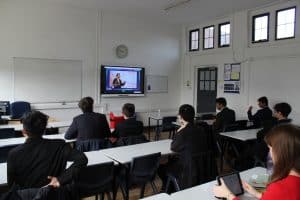 The Geography lectures were similarly wide-ranging. One talk, entitled Lessons in sustainability: An explorer’s tale, was by Jason Lewis, the first person to circumnavigate the earth without using motors or sails. Another featured academic Martin Evans, from the University of Manchester, speaking on Landscape Systems in the Anthropocene. And Emily Parry, Head of Geography, highlighted lectures on water insecurity and on how COVID-19 has impacted the Pacific Islands.
The Geography lectures were similarly wide-ranging. One talk, entitled Lessons in sustainability: An explorer’s tale, was by Jason Lewis, the first person to circumnavigate the earth without using motors or sails. Another featured academic Martin Evans, from the University of Manchester, speaking on Landscape Systems in the Anthropocene. And Emily Parry, Head of Geography, highlighted lectures on water insecurity and on how COVID-19 has impacted the Pacific Islands.
“The boys enjoyed the talks, which both built up content covered in their A-level course and extended their knowledge on a range of issues facing the planet,” she said.
“Each lecture was followed with a Q&A session in which the boys could send in questions to the lecturer. Often questions focused around what young people themselves could do to help address some of the issues explored such as climate change, river pollution and how we choose a sustainable future.”
Head of Biology Gillian Ridge said that after the forthcoming Biology in Action day, boys who attend will be invited to give a series of lunchtime presentations to the rest of their year based on the talks.


 Emily Parry, Head of Geography, said: ‘I was very impressed with the standard of submissions and the boys’ awareness of the potential impacts of climate change. The creative poems and stories clearly highlight the threat that climate change poses for all of us.”
Emily Parry, Head of Geography, said: ‘I was very impressed with the standard of submissions and the boys’ awareness of the potential impacts of climate change. The creative poems and stories clearly highlight the threat that climate change poses for all of us.”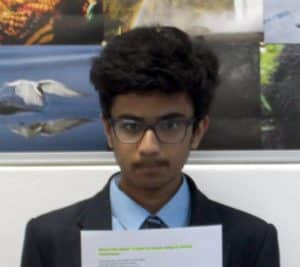 Most of Shreyas’s poem is equally bleak – “none of us will survive” – and he adds anger into the mix:
Most of Shreyas’s poem is equally bleak – “none of us will survive” – and he adds anger into the mix: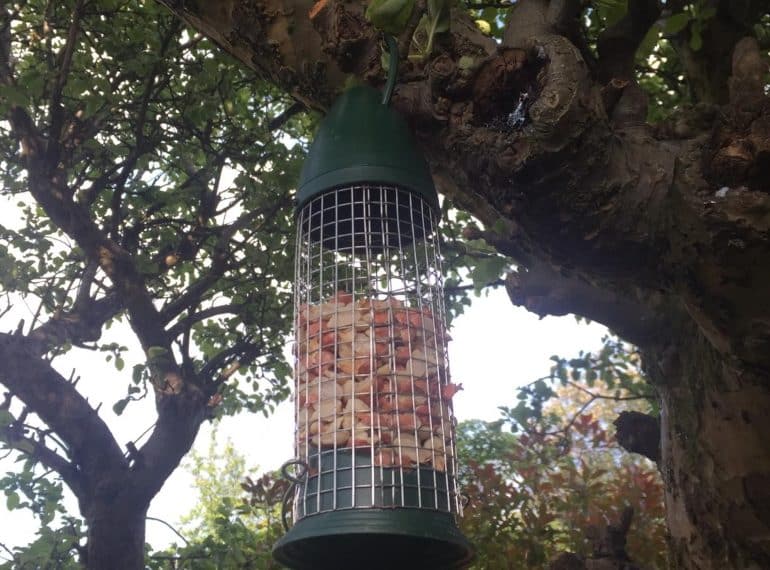
 With this year’s Earth Day theme being Climate Action, the winner of the writing competition emphasised the importance of using the right people to convey environmental messages, while the victor in the parallel photography competition emphasised the positive impact that even small steps could have.
With this year’s Earth Day theme being Climate Action, the winner of the writing competition emphasised the importance of using the right people to convey environmental messages, while the victor in the parallel photography competition emphasised the positive impact that even small steps could have.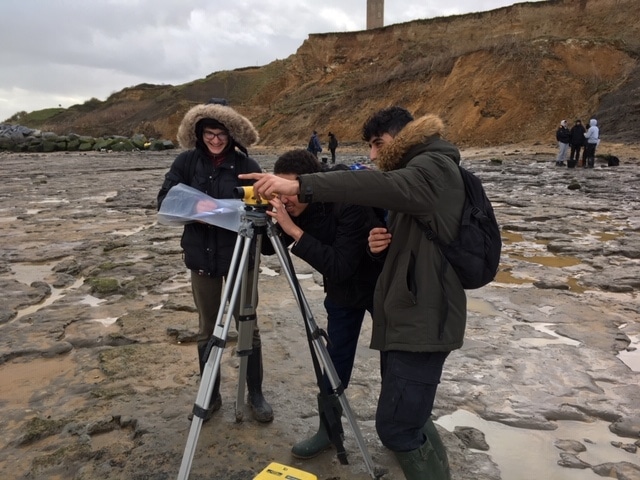
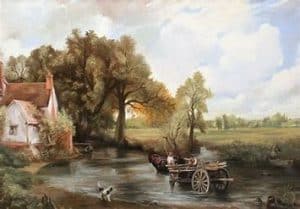 Despite freezing temperatures outside, the boys completed their fieldwork successfully during their stay at the historic Flatford Mill Studies Centre (FSC) at East Bergholt, Suffolk, on the River Stour, last month.
Despite freezing temperatures outside, the boys completed their fieldwork successfully during their stay at the historic Flatford Mill Studies Centre (FSC) at East Bergholt, Suffolk, on the River Stour, last month.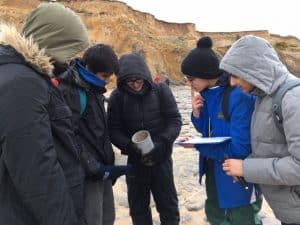 An outing to the coastal town of Walton-on-the-Naze across the river in Essex enabled the boys to look at the different social, economic and environmental thinking behind the variety of coastal management approaches.
An outing to the coastal town of Walton-on-the-Naze across the river in Essex enabled the boys to look at the different social, economic and environmental thinking behind the variety of coastal management approaches.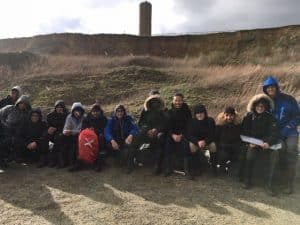 The fieldwork completed by the boys is examined as part of the AS examination.
The fieldwork completed by the boys is examined as part of the AS examination.
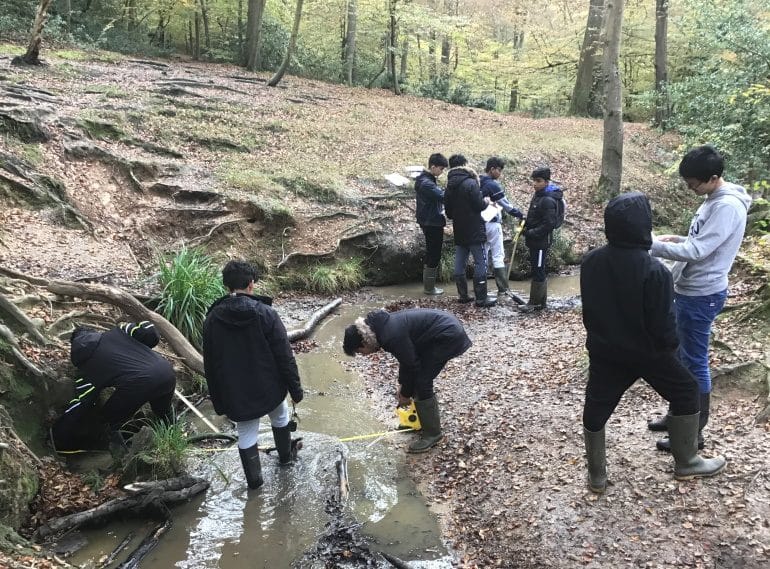
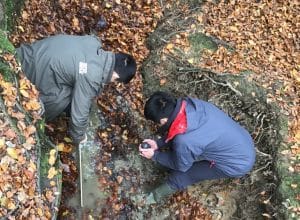 During the Physical Geography trip, the boys were tasked with investigating the question How do river characteristics change with distance downstream along Loughton Brook?
During the Physical Geography trip, the boys were tasked with investigating the question How do river characteristics change with distance downstream along Loughton Brook?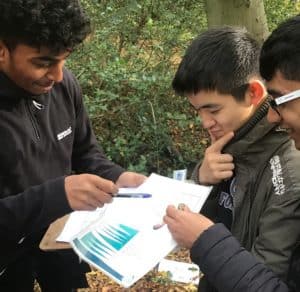 The field trip was spread over two days, with half of the cohort going each day, accompanied by four teachers.
The field trip was spread over two days, with half of the cohort going each day, accompanied by four teachers.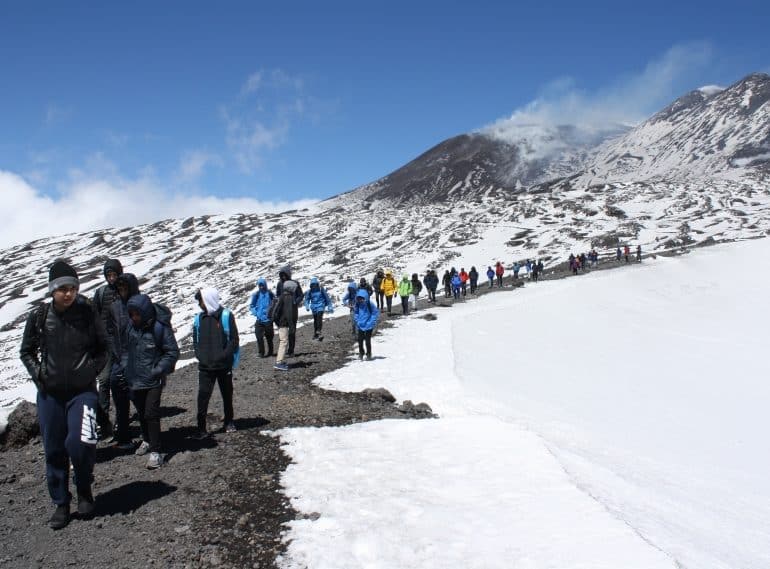
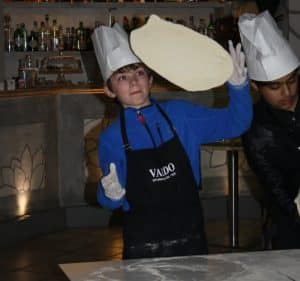 Forty-one boys from Years 7, 8 and 9 took part in the five-day trip led by Geography teacher Helen Davies, who was accompanied by four other members of staff.
Forty-one boys from Years 7, 8 and 9 took part in the five-day trip led by Geography teacher Helen Davies, who was accompanied by four other members of staff.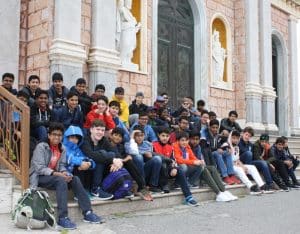 On the following day, after getting up at 5:30am, the boys set off for a full-day visit to the Aeolian Islands, a volcanic archipelago visible from Sicily.
On the following day, after getting up at 5:30am, the boys set off for a full-day visit to the Aeolian Islands, a volcanic archipelago visible from Sicily.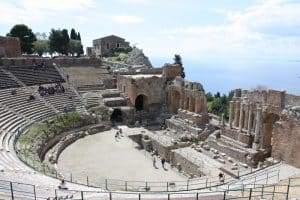 One evening activity popular with the boys was the visit to a restaurant, the Café Sikelia. There they not only learned about the history of the pizza and the different types available, but also had the chance to try their hand at making one themselves, before tucking into a pizza dinner.
One evening activity popular with the boys was the visit to a restaurant, the Café Sikelia. There they not only learned about the history of the pizza and the different types available, but also had the chance to try their hand at making one themselves, before tucking into a pizza dinner.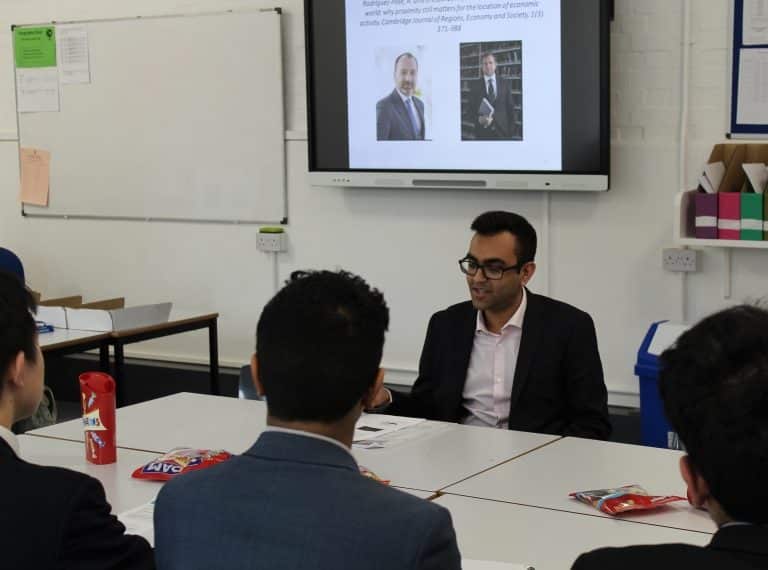
 Hemang Hirani (OE 2008-15), who studied Geography and Economics at the London School of Economics and is now working for Barclays, gave a presentation to the select group of Year 12 geographers entitled The role of cities: an introduction to the field of Economic Geography.
Hemang Hirani (OE 2008-15), who studied Geography and Economics at the London School of Economics and is now working for Barclays, gave a presentation to the select group of Year 12 geographers entitled The role of cities: an introduction to the field of Economic Geography. coded maps of the USA and India depicting the importance of cities in both advanced and emerging economies.
coded maps of the USA and India depicting the importance of cities in both advanced and emerging economies.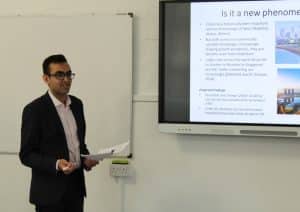 In his own time in the Sixth Form at QE, Hemang was a Senior Vice Captain. He has previously been involved in helping QE’s sixth-formers apply for Geography places at university.
In his own time in the Sixth Form at QE, Hemang was a Senior Vice Captain. He has previously been involved in helping QE’s sixth-formers apply for Geography places at university.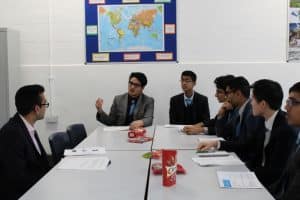 After graduating, he undertook a number of internships, including three months with Swiss investment bank and financial services company UBS as a Summer Analyst. He joined Barclays Private Bank in a similar role in June last year.
After graduating, he undertook a number of internships, including three months with Swiss investment bank and financial services company UBS as a Summer Analyst. He joined Barclays Private Bank in a similar role in June last year.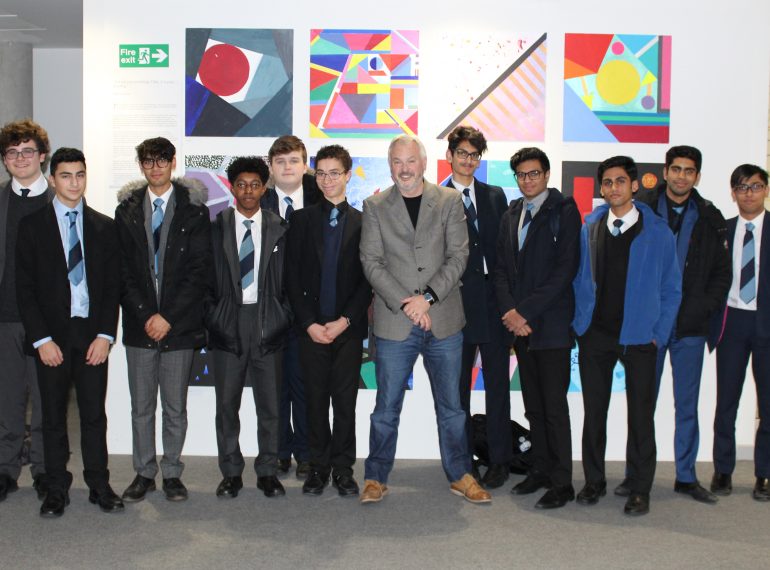
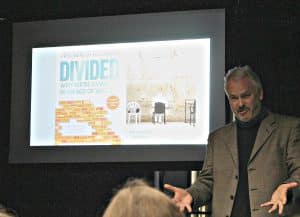 In an early-evening event, he spoke for 45 minutes on Divided: Why we’re living in an age of walls to an audience that included 11 QE boys, as well as QE’s Head of Geography, Emily Parry, Head of Politics, Liam Hargadon and Geography teachers Helen Davies and Nilisha Shah.
In an early-evening event, he spoke for 45 minutes on Divided: Why we’re living in an age of walls to an audience that included 11 QE boys, as well as QE’s Head of Geography, Emily Parry, Head of Politics, Liam Hargadon and Geography teachers Helen Davies and Nilisha Shah.
 While at university, he was Girton College Cricket Club First XI captain. He has continued playing since, and three years ago made the move from his childhood club, Potters Bar CC, to the thriving Old Elizabethans CC, where he is a wicketkeeper. He is pictured here (back row, far right) with the current Old Elizabethans First XI. The vice captain (Front Row, Second from the right) is OE Paul Lissowski, who was in the year above Charlie.
While at university, he was Girton College Cricket Club First XI captain. He has continued playing since, and three years ago made the move from his childhood club, Potters Bar CC, to the thriving Old Elizabethans CC, where he is a wicketkeeper. He is pictured here (back row, far right) with the current Old Elizabethans First XI. The vice captain (Front Row, Second from the right) is OE Paul Lissowski, who was in the year above Charlie.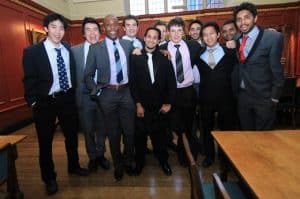 Charlie is pictured here, fourth from left, with a group of OEs who went to Cambridge with him. They arranged this reunion dinner in 2013, when he was in his third year.
Charlie is pictured here, fourth from left, with a group of OEs who went to Cambridge with him. They arranged this reunion dinner in 2013, when he was in his third year.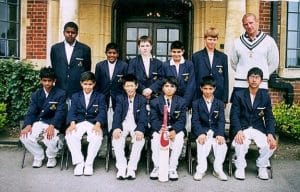 Outside of work, his decision to switch to Old Elizabethans CC has, he says, proved to be a fruitful one, as “two promotions in three years see the First XI playing the highest level of cricket in the club’s history”. Charlie is pictured here, back row centre, in his Year 7 cricket photo at QE.
Outside of work, his decision to switch to Old Elizabethans CC has, he says, proved to be a fruitful one, as “two promotions in three years see the First XI playing the highest level of cricket in the club’s history”. Charlie is pictured here, back row centre, in his Year 7 cricket photo at QE.